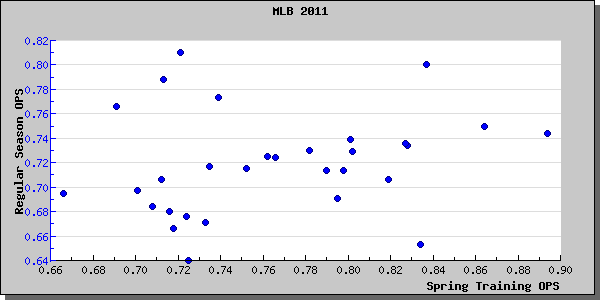Don’t Worry, A .650 is Just Fine
A 1-0 loss to the Red Sox? A pitchers duel between a pair of talented young starting pitchers, one on each side of the legendary rivalry? Under normal circumstances last night’s game in Tampa would have been a dagger to the heart of Yankees fans. But of the course the game was played in Tampa and had no bearing on American League Eastern division standings. The Yankees, 5-7 and near the bottom of the Grapefruit League, started at shortstop. The Red Sox, a much better 7-2, played Alex Hassan in left. The game didn’t matter – or rather, the story of the night was performance rather than his team’s loss. It’s as it should be and as it always will be. Baseball fans just don’t care who wins and loses in March.
Yet as little as we care about the wins and losses, as many times as we hear that nothing that happens between now and Opening Day really matters in the grand scheme of things, it’s tough to ignore abject failure. For those of us who do catch the games or check in on the box scores, some success is desired. And when failure occurs consistently in one or more facets of the game it’s difficult not to worry, not to let the thought cross your mind that maybe something is wrong with a key player or two and maybe the team that on paper looks to be among the best in recent memory is fundamentally flawed. We’re human beings. We have doubts and we often seek information that would confirm these doubts. Spring Training numbers and performance is a case in point.
So while fans have historically shown great maturity in dealing with Spring Training (in large part, I believe, because fans often ignore these games) there is the potential for a more informed fan to take a look at the Yankees’ performance thus far this spring and especially should it continue over the coming weeks and worry. While the Yankees pitching has been for the most part up to snuff, the same cannot be said for the offense. Entering last night’s shutout the Yankees had a .650 OPS in the month of March. Only two teams have hit fewer home runs, the Mets and the Orioles, and league rival Detroit has 19 bombs to New York’s 4 in the early going. This is despite the Yankees having played in more games than all but three Major League teams.
While the past couple of games and their respectively poor offensive performances got me thinking about team-wide statistics in spring, my initial thought was to dismiss entirely the numbers we have so far seen with the caveat that a full month of poor performance would be somewhat worrisome. As to the former I believe I was correct. After all, 13 games is hardly a lifetime in baseball. The Yankees have sent just over 400 batters to the plate and while this may be a reasonable sample size when evaluating a single players performance, a unit as variable and diverse as a team is subject to more rigorous examination. Plus, how many of those poor at bats were taken by players like the aforementioned Mr. Bernier who are highly unlikely to see any playing time in 2012?
A few. But of the Yankees nine regulars (I’ll count here) only three – , , and – have started the spring with an OPS north of .600! The other six, two thirds of the lineup, are hitting like minor leagues against pitchers who theoretically have an inherent disadvantage. The sample size is tiny but things aren’t going perfectly from a results standpoint. And that’s ok. After 13 games, there’s no need to panic. No one is panicking and hopefully very few will in the coming days and weeks. The more salient question is whether a full month – 25 or 30 games, over 1200 trips to the plate in aggregate – of poor performance would be something to worry about? If the team is hitting like this in two weeks, how concerned will and should we be?
On this issue, I had somewhat conflicting thoughts. Obviously spring doesn’t count, the sample sizes are tiny, and the numbers for individual players rarely cary over. But if in 1200-1400 trips to the plate this roster can’t hit inferior pitching, and still isn’t hitting at the end of the month, I’d have to give this some thought. Except… history shows us it really, truly, completely doesn’t matter. History shows us that even over the course of a full month, dozens of games, well over a thousand at bats, the sample size and environment is still nowhere near sufficient to make any judgements.
Just how insufficient is it? The Yankees ranked 25th in team OPS last spring. They ranked 27th the year before. They ranked 8th in 2009, though given the historic nature of that offense this could be viewed as a vast underperformance. But it’s not just the Yankees. Generalize this analysis to the entirety of Major League Baseball last season and we see a very, very poor correlation between spring training OPS (even over 1200-1500 plate appearances) and similar team performance in the regular season.
Perhaps a more interesting question would be whether the above data identified any surprisingly successful or unsuccessful offenses in 2011. The short answer is yes. The Kansas City Royals led all of baseball in OPS during Spring Training, and moved up more than ten spots in the regular season rankings over 2010. Meanwhile, the Twins proved a major disappointment as their poor spring may have indicated. Yet these “predictions” were the exception, not the rule. The Padres and White Sox certainly didn’t have big years, nor did the Yankees or Red Sox struggle to produce offensively after a rough spring.
Among fan overreactions, spring training failure is actually very tame. Fans tend to realize these games don’t matter. Few of them are televised and even the hard core among us are unlikely to poor over box scores. But while sabermetric research has demonstrated some minor correlation between breakout performances and exceptional springs among individual batters, no such connection can be found among teams in general. Even over 1200-1400 at bats, little can be gleaned. Even if the Yankees continue to hit for a .650 OPS into early April, this should be a source of absolutely no concern.
2 Responses to Don’t Worry, A .650 is Just Fine
Leave a Reply Cancel reply
-
LIKE TYA ON FACEBOOK
-
Recent Activity
Recent Posts
- 5/22 Yanks vs. Royals
- Raul Ibanez appreciation post
- Jump Starting the Offense Against Hochevar
- The Next Wave Of Bullpen Help
- An A-Rodd season
- May 21st Recap: Yankee struggles continue
- Game Thread 5/21: Royals at Yankees
- Identity Crisis: Who Are the 2012 Yankees?
- Nova’s Slider Giveth and Taketh Away
- Series Preview: Yanks vs. Royals: KC comes to the Bronx
Recent Comments
- BGrider85 on 5/22 Yanks vs. Royals
- Professor Longnose on 5/22 Yanks vs. Royals
- Eric Schultz on Raul Ibanez appreciation post
- ben on Raul Ibanez appreciation post
- ray on May 21st Recap: Yankee struggles continue
- ben on An A-Rodd season
- ben on An A-Rodd season
- Phil C on May 21st Recap: Yankee struggles continue
- ray on May 21st Recap: Yankee struggles continue
- Steve Sciacco on May 21st Recap: Yankee struggles continue
-
Authors
Twitter
* TYA Twitter -
* EJ Fagan -
* Matt Imbrogno -
* William J. -
* Larry Koestler-
* Moshe Mandel -
* Sean P. -
* Eric Schultz -
* Matt Warden -
-
Most poker sites open to US players also provide online casinos accepting USA players. A good example of this is BetOnline.com, where you can play 3D casino games, bet on sports or play poker from anywhere in the United States.
-
Other Links
-
Blogroll
Blogs
- An A-Blog for A-Rod
- Beat of the Bronx
- Bronx Banter
- Bronx Baseball Daily
- Bronx Brains
- Don't Bring in the Lefty
- Fack Youk
- It's About The Money
- iYankees
- Lady Loves Pinstripes
- Lenny's Yankees
- New Stadium Insider
- No Maas
- Pinstripe Alley
- Pinstripe Mystique
- Pinstriped Bible
- River Ave. Blues
- RLYW
- Steven Goldman
- The Captain's Blog
- The Girl Who Loved Andy Pettitte
- The Greedy Pinstripes
- This Purist Bleeds Pinstripes
- Value Over Replacement Grit
- WasWatching
- Yankee Source
- Yankeeist
- Yankees Blog | ESPN New York
- Yankees Fans Unite
- YFSF
- You Can't Predict Baseball
- Zell's Pinstripe Blog
Writers
- Bats (NYT)
- Blogging the Bombers (Feinsand)
- Bombers Beat
- Buster Olney
- E-Boland
- Jack Curry
- Joe Posnanski
- Joel Sherman
- Jon Heyman
- Keith Law
- Ken Davidoff
- Ken Rosenthal
- LoHud Yankees Blog
- Marc Carig
- Tim Marchman
- Tom Verducci
Resources
- Baseball Analysts
- Baseball Musings
- Baseball Prospectus
- Baseball Think Factory
- Baseball-Intellect
- Baseball-Reference
- BBTF Baseball Primer
- Beyond the Box Score
- Brooks Baseball
- Cot's Baseball Contracts
- ESPN's MLB Stats & Info Blog
- ESPN's SweetSpot Blog
- FanGraphs
- Joe Lefkowitz's PitchFX Tool
- Minor League Ball
- MLB Trade Rumors
- NYMag.com's Sports Section
- TexasLeaguers.com
- THE BOOK
- The Hardball Times
- The Official Site of The New York Yankees
- The Wall Street Journal's Daily Fix Sports Blog
- YESNetwork.com
-
Site Organization
Categories
Tags
A.J. Burnett ALCS Alex Rodriguez Andy Pettitte Baltimore Orioles Bartolo Colon Boston Red Sox Brett Gardner Brian Cashman Bullpen CC Sabathia Chien-Ming Wang Cliff Lee Curtis Granderson David Robertson Dellin Betances Derek Jeter Francisco Cervelli Freddy Garcia Game Recap Ivan Nova Javier Vazquez Jesus Montero Joba Chamberlain Joe Girardi Johnny Damon Jorge Posada Manny Banuelos Mariano Rivera Mark Teixeira Melky Cabrera Michael Pineda Minnesota Twins New York New York Yankees Nick Johnson Nick Swisher Phil Hughes Prospects Red Sox Robinson Cano Russell Martin Statistical analysis Tampa Bay Rays Yankees -
Site Stats






I agree 100%. I have already watched about 4-5 games and bristle at the lack of offense, but that is directly related to me watching and reacting to offensive failure. The human element of wanting your team to succeed, even if I never heard of half the payers. Meanwhile, the other part of my brain couldn’t care less. I’ve been a serious Yankee fan since 1965 (age 6) and know that the spring is really without much meaning. It’s for getting in shape, working on the fundamentals and various shortcomings. And maybe impress a manager, like my man Mitchell…1st call up of the season, YO!!!!
I would like to see the same scatter plot with the OPS of teams over the last 20 games of spring training. My belief, without data to prove the point, is that we need to totally ignore the first 15 games of the spring and then reset out view of stats. Pitchers are only in for a few innings, guys are rusty, some played winter ball etc. After a couple of weeks I think the field starts to solidify and good players start to put together decent springs (though we are still at the mercy of small sample sizes).